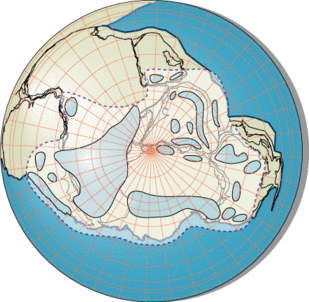Glaciation
After the “Cambrian Explosion”, 545 million years ago, the Late Ordovician glaciation (about 440 million years ago) was the first of three icehouse intervals that affected Earth once it was populated by animal life. From onset to meltdown, this glacial cycle was complete in less than 1 million years, but left in its wake Earth’s second largest extinction.
Some 100 million years after the Ordovician, Earth experienced its longest and most widespread glaciation, referred to as the Late Paleozoic Gondwanan Ice Age. Between 330 million and 270 million years ago, the serendipity of global mountain-building processes and associated basin formation, occurring while the supercontinent was assembling, enabled exquisite and widespread preservation of rock deposits worldwide that have been the subject of decades of research. Significantly, the Late Paleozoic Gondwanan Ice Age is the only example of climate change in an icehouse on a vegetated Earth, making it the nearest analog to Earth’s current state — and the only example of an icehouse-greenhouse transition that records the impact on animal and plant ecosystems in both the marine and terrestrial realms.
In the following section, we present an overview of the glacial deposits of North of Africa.
Late Ordovician Glaciation in Northern Gondwana
After Rubino et al., 2003
Glacial cycles
As all glacial episodes, the latest Ordovician records multiple cycles of advance and retreat of the ice cap. To date four to five cycles have been recorded. All the cycles are not necessarily recorded everywhere, because glacial incisions are not always superimposed but can be juxtaposed. All these phases define an overall retreating of the ice cap, however each phase records an advance of the ice followed by a flooding and progradation of depositional systems coeval to the ice retreat. A type cycle starts with a glacial erosion commonly outline by a glacial pavement developed at the base of the valley. Then rapid flooding occurs leading to the deposition of a condensed section or immediately followed by glacio-marine silty shales. Depending of regional location, sandy prograding units infill the valleys. Some other valleys are totally filled with fluvial sandstones, finally mixed infill also occurs with fluvial at the base and then deltaic systems.
This interpretation clearly establish that most of the so-called glacial succession is in fact commonly deposited in a marine environment. This confirms the pioneering works of Legrand which was claiming that transgression occurs before the Silurian.
Large scale architecture
Numerous glacial valleys have been identified, in outcrops, in Mauritania and Libya. These valleys define a network and are either juxtaposed or superimposed within the fairways. Each valley is filled by a single stratigraphic cycle however they can be reincised with numerous glacial pavements. The width range from 1 to 10 km. Very often gravity instabilities of pre-glacial deposits can be observed along the valley flanks. Their incisions seems to be related to the ice rather then fluvial processes. In this respects very few convincing examples of tunnel valley have been observed except in Mauritania.
The valley fill can dramatically change, some valleys being filled until the interfluve, some other are underfilled, leading to the preservation of pre-glacial buried hills below the Silurian shales. The final geometry of the late ashgillian succession have many similarities with the Quaternary succession in North Sea or in Celtic Sea where a grounded ice shelf had occur.
Silurian trangression
Silurian transgression is usually interpreted as the post glacial trangression, we have already seen that the first transgression occurs during latest Ordovician. In this respect, it means that the glacial retreat is punctuated and the Silurian transgression probably records the final melting. The transgression is diachronous depending of the preexisting topography. Source rock seems to occur predominantly in regional lows, either resulting from glacial erosion or fluvial incision possibly related to the isostatic rebound. These lows in combination with late deformation will control the migration pathways. The sandy glacial deposits or the lowermost silurian transgressive sandstones deposited immediately below the source rock is the first reservoir to be filled or at least used for the migration has indicated by the abundance of shows. When the Late Ashgillian (circa 450 my) succession is more shally or silty, it could form a waste zone or at least strongly reduce the potential column.
